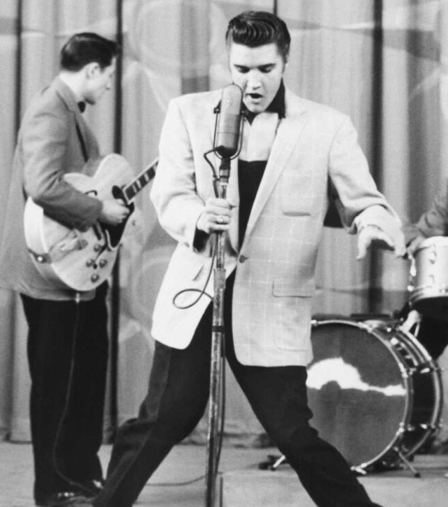“Hound Dog” is more than just a song; it’s a cultural phenomenon that encapsulates the dynamic evolution of popular music in the 1950s. Originally written by Jerry Leiber and Mike Stoller, the track first found life in the voice of blues singer Willie Mae “Big Mama” Thornton before being transformed into a rock ‘n’ roll classic by Elvis Presley.
The Birth of a Blues Classic: Big Mama Thornton’s “Hound Dog”
The story of “Hound Dog” begins with Willie Mae “Big Mama” Thornton, whose 1952 recording of the song became an instant hit on the R&B charts. Leiber and Stoller, who were just beginning their careers as songwriters, crafted the song specifically for Thornton, infusing it with the raw emotion and gritty realism that characterized much of the blues genre. Thornton’s powerful, deep voice lent an authenticity to the song’s narrative, transforming “Hound Dog” into a poignant expression of frustration and betrayal.
Thornton’s version of “Hound Dog” is steeped in the traditions of the blues—a genre that often serves as a vehicle for personal and social commentary. The lyrics of the song, which compare a faithless lover to a “hound dog,” reflect the resilience and defiance of a woman scorned. Thornton’s delivery, slow and deliberate, emphasizes the song’s emotional weight, making it clear that the “hound dog” in question has worn out his welcome.
The success of Thornton’s “Hound Dog” was significant not only for its musical impact but also for what it represented within the context of the early 1950s. At a time when the music industry was still largely segregated, Thornton’s hit proved that African American artists could achieve mainstream success. However, despite the popularity of her recording, Thornton did not receive the full credit or financial rewards she deserved—a common plight for many black artists of the era.
Elvis Presley and the Rock ‘n’ Roll Revolution
When Elvis Presley recorded his version of “Hound Dog” in 1956, he not only reinterpreted the song but also helped to redefine the landscape of popular music. Presley’s rendition of “Hound Dog” is faster, louder, and more energetic than Thornton’s original. With its driving beat and infectious rhythm, the song became emblematic of the burgeoning rock ‘n’ roll movement—a genre that blended elements of blues, country, and rhythm and blues into something entirely new.
Presley’s version of “Hound Dog” is often credited with helping to bring rock ‘n’ roll into the mainstream. His performance of the song on “The Milton Berle Show” in June 1956 is particularly famous, not only for its impact on his career but also for the way it captured the spirit of rebellion that rock ‘n’ roll came to symbolize. As Presley swiveled his hips and delivered the lyrics with a playful sneer, he electrified audiences and solidified his image as a cultural icon.
The transformation of “Hound Dog” from a blues lament into a rockabilly anthem is a testament to Presley’s ability to reinterpret and recontextualize music. Where Thornton’s version was a stern dismissal of a wayward lover, Presley’s take on the song is more lighthearted, almost mocking. The “hound dog” in Presley’s version is not just a bad lover but a laughable figure—a metaphor for anyone or anything that is trying, and failing, to keep up with the new, fast-paced world of rock ‘n’ roll.
Cultural Implications and the Legacy of “Hound Dog”
The journey of “Hound Dog” from the juke joints of the South to the stages of national television highlights the complex intersections culture and music in mid-20th century America. Thornton’s original recording reflects the experiences and emotions of African American women, whose voices were often marginalized in mainstream culture. In contrast, Presley’s version, while undeniably a product of his own talent, also raises questions about cultural appropriation—a topic that continues to be relevant in discussions of music and race.
Elvis Presley was often celebrated for his ability to popularize songs and styles that originated in African American communities, but this success also brought scrutiny. While Presley’s version of “Hound Dog” opened doors for rock ‘n’ roll, it also overshadowed the contributions of artists like Thornton. The story of “Hound Dog” is, therefore, not just about the evolution of a song, but also about the broader dynamics of power and recognition in the music industry.
Despite these complexities, both versions of “Hound Dog” have left an indelible mark on music history. Thornton’s recording is revered as a seminal blues track, a reminder of the genre’s emotional depth and storytelling power. Meanwhile, Presley’s version has become one of the defining songs of the rock ‘n’ roll era, influencing countless artists and helping to shape the sound of popular music for decades to come.
“Hound Dog” is more than just a catchy tune; it is a piece of music history that encapsulates the evolution of American popular music in the 1950s. From its origins as a blues anthem in the voice of Big Mama Thornton to its transformation into a rock ‘n’ roll classic by Elvis Presley, the song tells a story of creativity, adaptation, and cultural exchange.
The different interpretations of “Hound Dog” reflect the versatility of the song and its ability to resonate with diverse audiences. Whether as a powerful blues lament or an energetic rockabilly anthem, “Hound Dog” remains a testament to the enduring power of music to capture the spirit of its time while transcending the boundaries of genre and generation.
No comments yet.








